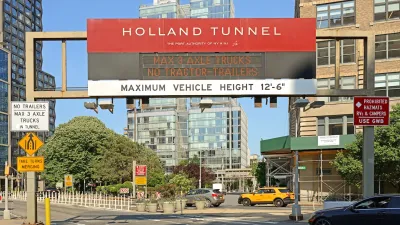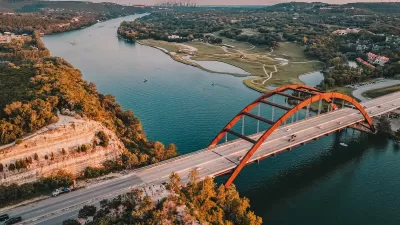In a previous blog post, my discussion of externalities, public goods and roads spurred an unexpectedly lengthy set of posts and repostes. In this article, I want to address a trickier topic: Whether road users have effectively shifted the burden for paying for roads to non-users and whether the reason we pay for roads out of general taxes is a result of that lobbying effort.
In a previous blog post, my discussion of externalities, public goods and roads spurred an unexpectedly lengthy set of posts and repostes. In this article, I want to address a trickier topic: Whether road users have effectively shifted the burden for paying for roads to non-users and whether the reason we pay for roads out of general taxes is a result of that lobbying effort.
Some planners have referred to this process (if I interpret their comments correctly) as "externalizing" the costs of providing services and goods. Essentially, the idea boils down to whether a private good is paid for by the general public when the general public doesn't benefit from its provision; it's a version of privatizing the benefit while socializing the cost. At its core, this is a question of subsidization.
I'll continue to use roads because that's the case in which the term emerged, and this topic seems to create the most controversy in the planning community. And, let me acknowledge from the outset the obvious: The vast majority of roads are subsidized in the sense they are funded by government. The question is the degree of subsidization by non-users and whether those subsidies should continue.
On the surface, the case for automobile users externalizing the cost for roads makes sense. Tolls, gas taxes, and other user fees made up just 52.5 percent of the revenues spent on highways nationwide in 2008 according to the Federal Highway Administration (Table HF-1). The share ranged from just 28 percent in Arizona to 82.3 percent in West Virginia. Moreover, the U.S. General Accountability Office recently found that federal general fund transfers to the Highway Trust Fund have been significant enough to make every state a "donor" state based on pure dollars flowing in and out of the account.
But, this breakdown is a little too facile. Not all roads serve the same purpose or lend themselves to user-fee applications. Moreover, the public benefit properties of roads have been recognized for centuries (and even discussed by Adam Smith in the Wealth of Nations). The U.S. Constitution explicitly enables the U.S. Congress to authorize funding for Post Roads. The economic returns to the investment in the Interstate Highway System ran into the double digits during its early decades (financed by the gas tax) as the efficiencies of improved mobility translated into stronger bottom lines for U.S. business. Road building dramatically curtailed urban traffic congestion to the point only Los Angeles faced severe regional traffic congestion in 1982. The returns to highway investments have declined in recent decades. While the causes are not well known, many analysts believe the increased politicization of road funding and diminishing marginal returns to investments as a national network play important roles.
As a practical matter, if a strict user fee approach to road finance had been in place prior to the mid-20th century, quite simply very few roads would have been built, let alone improved or adapted to changing economic circumstances. A fascinating short history of U.S. tollroads and their economic demise in the 19ths century can be found in Daniel B. Klein's extensive work and his summary at EH.net with John Majewski.) The economic and social implications of severely curtailed road building would have been decidedly negative.
But, as the saying goes: Then was then, and now is now.
Personally, I support privatizing the entire road system. I've been publicly supportive of a distance-based fee (probably based on vehicle miles traveled) that is set to ensure free-flow travel. I believe that a price at this level would be "market clearing," eliminate the need for public subsidies, rationalize modal choice, improve land-use efficiency base on more transparent transportation costs, and generally improve urban economic competitiveness. (By implication, our failure to price roads has led to a general oversupply of roads although the local circumstances vary.)
Nevertheless, the reality is that systemwide road pricing is not quite technically feasible, currently impractical, and economically infeasible for most of the road system in 2010. The technology is close (within 20 years), as the recent road-user fee pilot project in Oregon demonstrated, but we aren't quite there yet. Limited access highways? Yes. Collector roads? Maybe. Local roads? No.
Which gets us back to the original issue at hand: If mobility has general social and economic benefits, and roads are key elements of providing that mobility, than the idea that we fund roads largely because a narrowly defined group of users have manipulated the process to off-load those expenses to nonusers is pretty weak. We tend to forget that the basic skeleton (and design) of most urban road systems predated the widespread use of the automobile. Moreover, in the case of federal interstate highways at least, the gas tax covered virtually all the construction costs until recently. Indeed, a recent Reason Foundation analysis of a re-purposed Highway Trust Fund suggests that gas taxes could cover the needs of the federal Interstate Highway System if current gas tax revenues were rededicated to that function. So, in the broad sense, users paid (and could continue to pay) for federal interstates.
But, roads are more than federal interstates.Local and neighborhood roads provide different levels of service, and we don't yet have the technology to apply real user fees to these roads. Local roads are still largely public goods for practical purposes.
So, are road users externalizing their costs? Road investments have historically predated the widespread use of the automobile and modern-day urbanization in concept if not scale. The grid street pattern pre-dated the automobile as well as the system of roads knitting rural villages and towns to urban areas.
I don't believe road users externalized the costs of roads as much as governments recognized their social benefits (for commercial purposes as well as passengers) and the practical inability of the private sector to provide those facilities and services. As a consequence, governments dedicated funds to building what was considered social infrastructure that served rural and urban purposes.
Now, the rationale for non-user based public expenditures on roads and highways is weakening, and weaker by the decade with each new spurt in technology. While we can expect intense lobbying by current users to retain the subsidies they have, that's not the same as arguing that the reason we subsidize public infrastructure is because of special-interest lobbying for a redistribution of funds away from non-users to support their own narrow projects. The more productive discussion, I believe, is over whether the rationale for public funding of roads exists any longer and how to phase it out.

Planetizen Federal Action Tracker
A weekly monitor of how Trump’s orders and actions are impacting planners and planning in America.

Maui's Vacation Rental Debate Turns Ugly
Verbal attacks, misinformation campaigns and fistfights plague a high-stakes debate to convert thousands of vacation rentals into long-term housing.

San Francisco Suspends Traffic Calming Amidst Record Deaths
Citing “a challenging fiscal landscape,” the city will cease the program on the heels of 42 traffic deaths, including 24 pedestrians.

Defunct Pittsburgh Power Plant to Become Residential Tower
A decommissioned steam heat plant will be redeveloped into almost 100 affordable housing units.

Trump Prompts Restructuring of Transportation Research Board in “Unprecedented Overreach”
The TRB has eliminated more than half of its committees including those focused on climate, equity, and cities.

Amtrak Rolls Out New Orleans to Alabama “Mardi Gras” Train
The new service will operate morning and evening departures between Mobile and New Orleans.
Urban Design for Planners 1: Software Tools
This six-course series explores essential urban design concepts using open source software and equips planners with the tools they need to participate fully in the urban design process.
Planning for Universal Design
Learn the tools for implementing Universal Design in planning regulations.
Heyer Gruel & Associates PA
JM Goldson LLC
Custer County Colorado
City of Camden Redevelopment Agency
City of Astoria
Transportation Research & Education Center (TREC) at Portland State University
Jefferson Parish Government
Camden Redevelopment Agency
City of Claremont





























